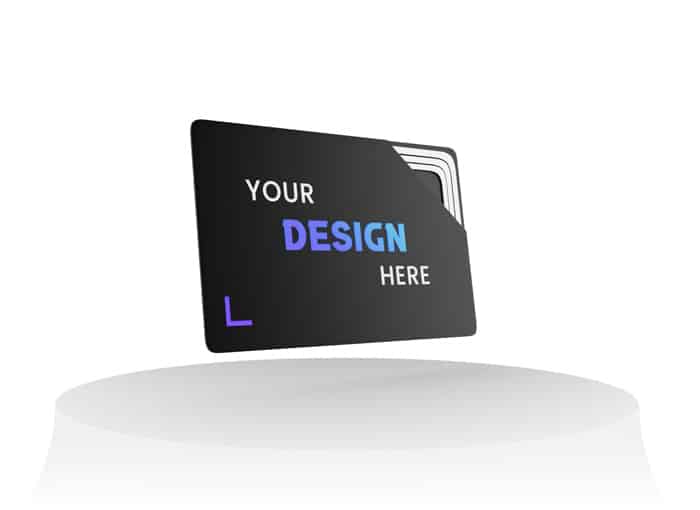
Why does having a business card equipped with an NFC chip and a QR code really make a difference?

In this article, we take stock of the situation and answer some of the main questions that may arise in the light of these technological developments.
A brief definition of the virtual business card
If you look at it from a distance, you might mistake it for a traditional business card.
But if you take it in hand, you’ll notice that it’s even more rigid.
What’s more, the digital business card, or VKARD for Virtual Card, isn’t necessarily made from a plastic-like material: you can choose wood if you prefer a very natural look, or even metal if you prefer originality!
Like its printed counterpart, the VKARD includes the person’s first and last name, as well as their job title, company, postal address, telephone number and e-mail address.
Thanks to the power of the NFC chip and the files accessible through the QR code, you can also add one or more website addresses, links to social networks and even share data such as PDF files or images: it’s obviously very rich and much more powerful than the paper business card.
And then there’s the undeniable advantage of cost.
Once it’s been manufactured and put into service, a digital business card can be used thousands of times: there’s no need to have multiple copies made.
If you’re particularly concerned about protecting the environment and reducing the ecological impact on nature, then VKARD is an excellent choice.
It’s the NFC chip inside that will take care of transmitting your contact details and any relevant information to each of your contacts: so there’s no risk of “running out of stock” or finding yourself chatting with a customer without being able to hand over your business card!
Why use an NFC-enabled business card?
Have you ever paid for goods in a shop simply by placing your smartphone on a small terminal?
Then you’ve already used the NFC chip built into your cell phone!
It’s so practical that we don’t always notice it…
And yet, this specific component using NFC (Near Field Communication) technology is the result of a technological feat that enables contactless data transfer over short distances.
But business cards can also benefit from this technology, especially as this type of chip is very thin, making it easy to fit inside.
There are several advantages to choosing a business card with an NFC chip.
In particular, you’ll be able to broadcast your contact details with no risk of error and with great speed, since all your contact has to do is bring his or her smartphone close to your digital business card for the data to be transmitted immediately.
What’s more, you can update the information whenever you like, since it’s stored on a server to which you normally have access: as soon as the operation is completed, your NFC-enabled business card will share the new information.
This is much more flexible than traditional business cards, which, when a piece of information was wrong, became unusable: you then had to start manufacturing a new series!
What’s more, unlike the QR-code, which works very well but requires your interlocutor to come and scan it, the NFC chip automatically delivers the information it contains without the need for any manipulation: day-to-day use is really made easy.
All in all, the advantages of an NFC chip on a business card can be summed up as follows:
- no need to connect cell phones to each other with cables, data transmission is contactless
- the virtual business card has no battery to power the NFC chip, so it can be used 24 hours a day and never needs recharging!
- NFC chips are highly secure and very difficult to clone
- as the range is very short, just a few centimeters, it’s also very difficult to hack them without having to be close to the digital business card
- information can be updated easily and without delay
- all modern phones can be equipped, whether they belong to the Android or iOS family.
What are the advantages of QR codes for business cards?
Did you know that QR stands for Quick Response?
The QR code is simply a drawing that is often interpreted as a square filled with small black and white dots: in fact, it’s a barcode with a special layout.
The advantage of the QR code is that it can store more information than the traditional barcode: in particular, its code can trigger actions on your interlocutor’s terminal, such as opening a browser or address book to automatically enter your contact details.
To use it on a business card, simply scan it with a smartphone or tablet, and almost immediately, a software application opens, allowing you to take advantage of the information shared.
As the QR code is a drawing, it can be printed anywhere, and best of all, it doesn’t require your interlocutor’s cell phone to be equipped with an NFC chip: today, all smartphones are capable of taking photos and scanning a document!
It’s the easy, almost universal solution!
On the other hand, unlike the NFC chip, the QR code is not secure: anyone can see it and scan it, even if you don’t want to broadcast the information it refers to.
It can also be easily copied.
This isn’t a problem in itself, but it is one you need to be aware of when you’re a professional and may need to distribute sensitive information to certain people only.
Finally, while the QR code is very reliable, it needs to be legible if it is to be scanned at the right quality: if a mark or trace is visible, it may not work well.
Despite these observations, a VKARD with a QR code is an extremely effective means of communication, since it doesn’t oblige the person you’re talking to to copy your contact details, at the risk of making mistakes, especially if there’s a lot of information (links to social networks, website addresses, codes for downloading images or videos, etc.).
What’s more, as with the NFC chip, the QR code acts as a kind of gateway between the smartphone of the person with whom you’re exchanging and the server where your data is stored: if you need to update your information, it will be done very easily and without delay, since all you have to do is connect to your account to make the changes.
Finally, don’t forget that while your QR code is of course present on your virtual business card, it can also be inscribed in an e-mail or even inside a traditional letter written or printed on paper: important information will thus be easily transmitted.
We’ve come to the end of this article.
As you can see, there are practically nothing but advantages in choosing these “new-generation” business cards – VKARDs – equipped with an NFC chip and a QR Code.
Practical, reliable and economical, they’re virtually flawless.
What’s more, manufacturers are ingenious and can even offer you highly original models with a particular graphic look or materials that will inevitably catch the eye of your prospects and customers.
And if you’re a company working in the IT or NTIC world, it’s a good idea to show your interest in new communication media!
Written by Camille BODET
The digital business card is a real ally for professionals wishing to promote their business effectively and instantly. In the...Lire la suite
VKARD is an innovative and effective solution to help all professionals stand out from the crowd and reinforce their brand...Lire la suite
If you prepare properly for a job interview, you'll have every chance of winning over the recruiter and getting the...Lire la suite
LinkedIn is a world-renowned business platform, and for good reason! Thanks to its many networking options, LinkedIn is the tool...Lire la suite
Find out how Leexi AI optimizes the management of videoconferences and business calls, saving time and improving efficiency.
In the professional sphere, it's vital to know how to convey certain strong values in order to stand out and...Lire la suite
Mastering the art of conversation is a real asset! By mastering the subtle art of conversation, you'll be able to...Lire la suite
Are you taking part in a trade event and want to do everything you can to make a good impression?...Lire la suite
CRM (Customer Relationship Management) represents a genuine corporate strategy for managing business contacts. This popular tool for professionals is in...Lire la suite
At a time when the professional world is in a perpetual state of competition, we might wonder what place altruism,...Lire la suite















